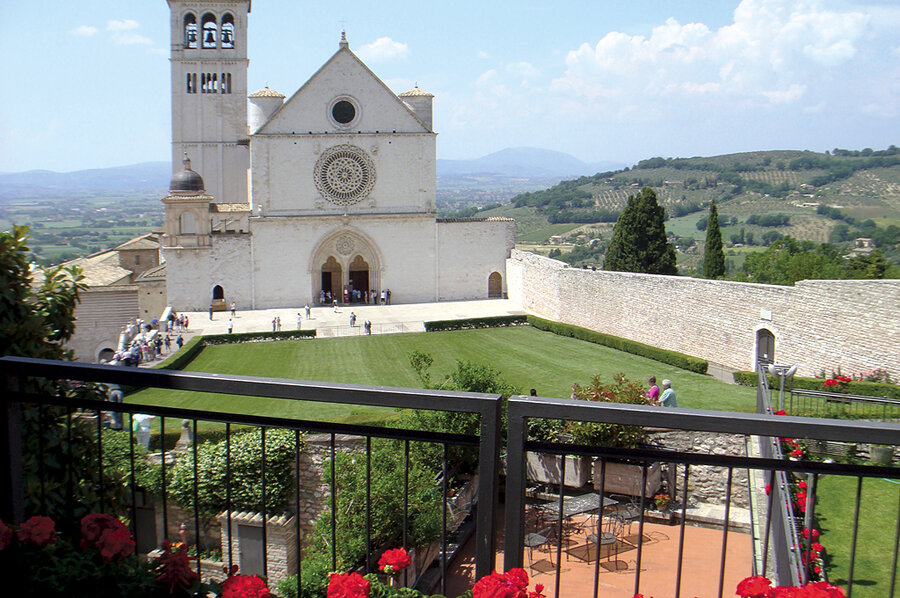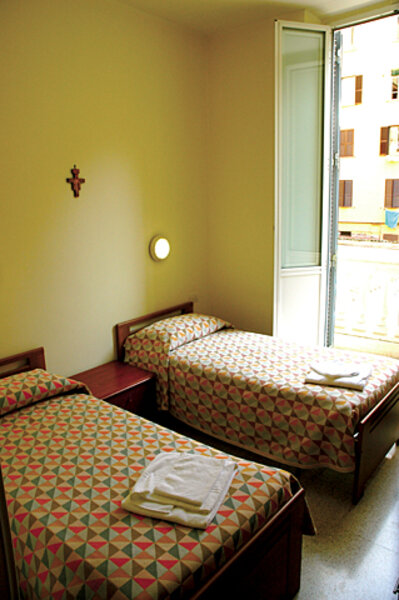Prayers optional: A vacation spent at Italy's religious guesthouses
Loading...
We hear the Italian nuns chanting their prayers as we creep down the convent stairs each evening, heading out to find yet another heavenly setting in which to dine on still more of their country's divine abundance.
My 22-year-old daughter and I are staying in religious guesthouses while touring Italy, a popular option in the dozen or so years since several guidebooks sent the idea into the travel mainstream.
At most such places, guests are invited, but not expected, to pray with the hosts. And if Italian was our native tongue, we'd probably join in. But the lack of shared language makes us wary of becoming consumers of things spiritual, looking to check "vespers" off an itinerary. Already, choosing the convent option in a country centered on religion risks trivializing it in a grasp at authenticity. So we opt for dinner.
Kevin J. Wright, travel industry expert and author of "Europe's Monastery and Convent Guesthouses," estimates that hundreds of Italian monasteries and convents – most with only a dozen or two rooms to rent – take in many thousands of travelers each year. Low prices, notoriously clean rooms, a family feel, and the safety of the enclosures are the big draws. And though virtually all are owned by Roman Catholic communities, they shelter travelers of all faiths.
Eileen Barish, author of "The Guide to Lodging in Italy's Monasteries," is Jewish and likens the experience to staying in the home of a welcoming, non-Jewish friend. She drinks in the history, architecture, and even the religious imagery in the buildings, she says. "I go to the chapels when I'm there because they're so beautiful."
Rome, the "home office" for Catholic congregations worldwide, houses the greatest concentration of such lodgings. Taking in guests allows the communities to sustain themselves even as their ranks are thinning, and a public eager for new and different travel experiences – even the experience of reflection or silence or spiritual growth – is there to help, says Mr. Wright. He estimates convent and monastery rates to be at least one-third lower than comparable nonreligious lodgings. The houses vary greatly. Some offer little more than a bed and a hall bath. Others have air conditioning, Internet access, private baths, and in-room TVs – recent innovations made in response to market forces.
Mark Logan, of the online booking website monasterystays.com, says the United States, Canada, and Australia supply the lion's share of convent/monastery business, typically couples in their 50s who've already done the requisite guided tour of Italy, as well as families and budget-minded travelers of all ages.
No matter how welcome the income may be for the hosts, hospitality first and foremost emanates from a biblical mandate to welcome the stranger, explains Brother Richard Oliver, webmaster for the Order of St. Benedict, the community most directly associated with monastic hospitality. Even in the case of visitors who come without an overt religious purpose, this theology considers the mystery of God to be ever at work, he explains: "There's some reason they're doing this rather than a cheap motel. You never know what someone has to give."
As early as the 3rd century AD, the desert fathers made hospitality a priority. Later, Benedict, the father of Western monasticism, elaborated on it in his famous rule: "Let all guests who arrive be received like Christ, for He is going to say, 'I came as a guest, and you received Me' " (a paraphrase of Matt. 25:35).
The most traditional – and conservative – abbeys are run by monks and nuns of the Cistercian, Trappist, and Benedictine orders, and guests there are generally expected to participate in the community's spiritual life, Brother Richard explains, since their very presence suggests some desire for retreat, silence, or discernment.
Creature comforts are fewer at these traditional abbeys, where house rules, curfews, and prayer schedules are common. Some convents and monasteries accept only men or only women, though even the more relaxed houses expect that couples be married.
No matter where we stay we find twin beds, crisp sheets, gleaming floors, a reading lamp, a lower than average number of mirrors, and a crucifix on the wall. Even though our digs are plush by hermitage standards, some things are missing – computer, remote control, outside news, the incessant need to try this and visit that. But the lack of these things makes room for the new. "I feel like I can hear my thoughts again," my daughter announces two days in.
Funny, because pulling up at Villino Noel, run by the Oblate Missionary Sisters of the Assumption on Rome's loud and busy Via Andrea Doria, you would expect to hear only traffic. Sharing the sidewalk with a gas station, the convent gate looks like the entry to an impound lot for cars. But on the other side lies a delightful garden refuge made all the sweeter by the fact that – despite a note asking that guests respect the silence – there's a table for eight here. Several garrulous Italian couples put the spot to happy use (silence, in these places, being something of a moving target).
The garden also contains the little devotional shrines popular in Italy: a statue of Mary, a glass-protected wall grotto with a statue of Jesus, a Scripture verse in French. And in a city where ideas and religion and art and civilization history all tend to be delivered in overwhelming proportions to a relentless moving mass of humanity, this little convent is a treat.
Sloughing off the grand of Rome
Forget Bernini's David and what giant he might slay today. Nevermind your philosopher-guide Gabriella and her contention that an olive tree never dies. Stop wondering why people take so many pictures. Villino Noel sloughs off all the grand of Rome while retaining the essentials, and religion emerges faithful, human – five nuns making sure you're in at night, the eldest putting down her lacemaking to investigate, on hands and knees, a plumbing problem.
We have the key to the convent gate here in Rome, so there's no curfew. Elsewhere, we have to ring the bell to get in, and thus need to be back by 10 or 11 p.m. so our hosts can get to bed.
Unlike in hotels, where staff usually speak some English, calling for reservations is tricky because Italian is the norm. Showing up unannounced is not advised. And though some houses may accept what donation a guest offers, the days of trading dishwashing duties for a night's sleep have yielded to the need to handle real estate wisely or risk losing it.
Travel books can help turn up prospective lodgings, and the Church of Santa Susanna, in Rome, lists religious houses and links on its website. For an extra 20 percent or so, online sites like monasterystays.com will book a stay, eliminating language confusion and speeding reservations for those in a hurry. We paid the convents €65 ($93) a night in Assisi, and €80 ($115) a night in Rome and Florence, including breakfast.
In the medieval, friar-filled town of Assisi, where virtually all of life seems to pay homage to the beloved St. Francis, Italy's patron, it would seem odd not to take shelter in a convent.
The Istituto Beata Angelina, just across the green from the basilica of San Francesco – and its Giotto-covered walls and throngs of pilgrims – did the job well. Here, in a pristine, light-bathed restoration of an 18th-century house damaged in a 1997 earthquake, a staff of five Franciscan nuns run things. There's the young Suor Angela, whose welcome tour is a spirited mix of sign language and charades. She kisses her fingers with a gusto others reserve for things culinary as she entreats us to visit the basilica in the very early hours as the friars chant their morning prayer, promising a singular experience of "il silenzio." She does not disappoint.
Later, house director Suor Clotilde, an animated Italian version of the affirming reverend mother, waits up for us with destination information and travel times. Lodging is just the starting point for the nuns' ministry. Their mission, she explains with the help of a friar from the Philippines, is to provide a place for reflection and spiritual understanding, especially for youths, families, and those who are discouraged. She tells of her successes – a troubled teen who found peace at the convent and now works with others in crisis; a married couple moving toward divorce who rediscovered each other's "beauty" while there; a couple who met there and are now married.
We agree that we could see ourselves coming to a place like this if ever we were bereft.
Wearying by the end of our trip, at Istituto Suore di Santa Elisabetta in Florence, we were relieved to find the English-speaking Carmen at the desk and a hair dryer in the bathroom. Like the city itself, this opulent villa, abuzz with activity, feels more secular, akin at times to a casual hotel. Its garden is as resplendent with gnome collections and cement deer as with religious artifacts, yet its chapel is well used, with reading glasses, prayer books, and devotional items marking individual nuns' favorite spots.
Guests are invited to morning mass, but as elsewhere, often skip it. One German teacher, traveling alone and wrapping up a three-week stay there as part of a sabbatical year, says bluntly that she chose the convent for reason of personal safety.
Nonreligious hospitality
Headed home, we make an unscheduled stop at Della Signoria, a little three-star hotel near Florence's famed Ponte Vecchio.
Here, we are surprised to find another – albeit pricier – piece of paradise: a sweet breakfast balcony awash in home-stitched floral cushions, pink damask tablecloths, and white wrought-iron furniture. A Christmas cactus blooms atop each table, and a mass of overflowing planters provides screening from the crowds below.
As she pours a guest a second cup of coffee, longtime owner Rita Lippolis quietly describes her decades-old relationships with guests. "They come to us in good times and bad," she says.
And as she talks about the honor of receiving travelers in their sorrows as well as their joys, you began to picture Mrs. Lippolis and her kindly staff adorned in the head-covering veils of the suore, their gray server uniforms cinched at the waist with rope, evidence that there are many ways a house becomes holy.






